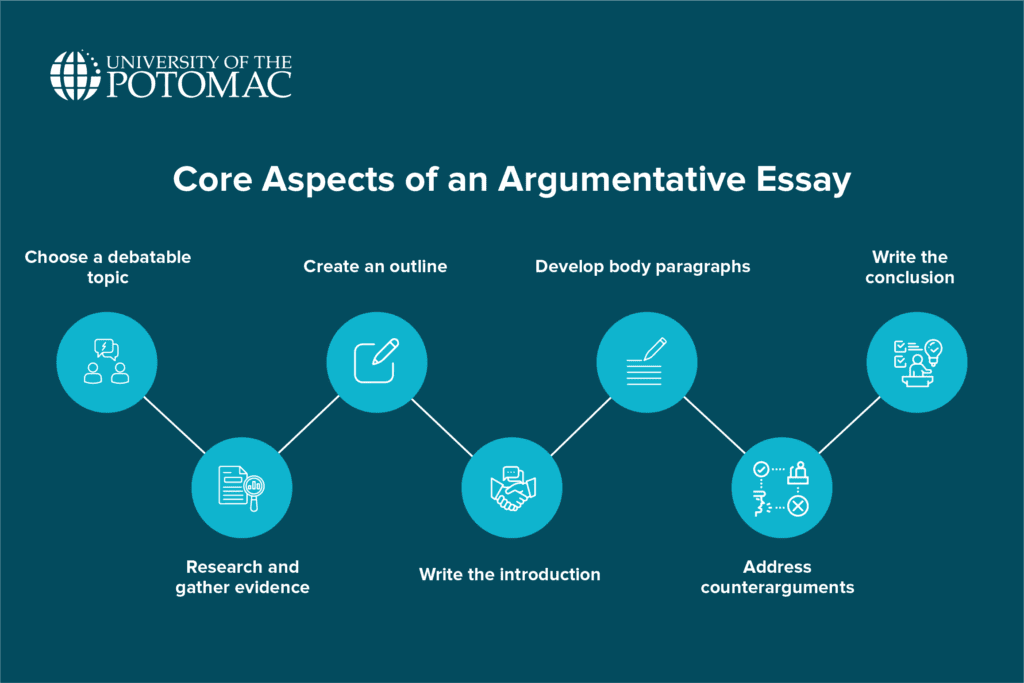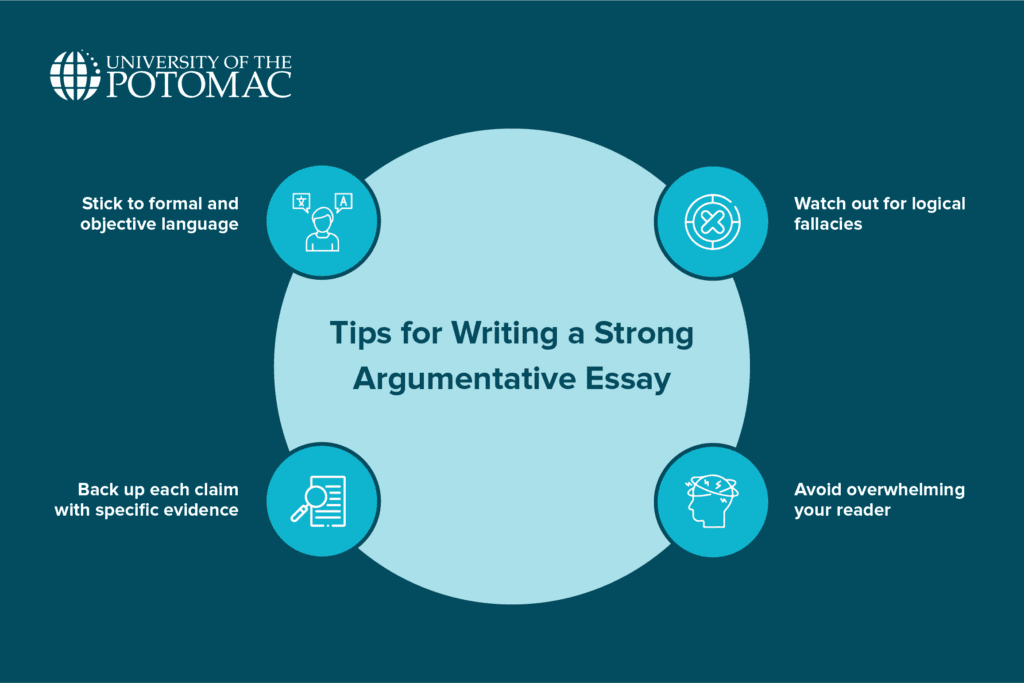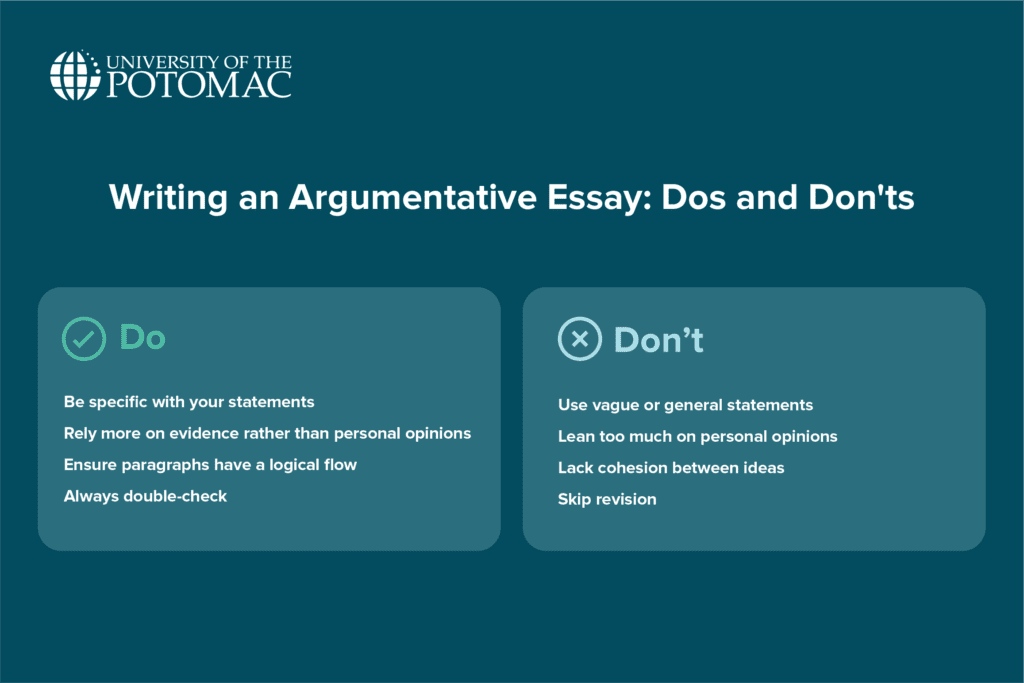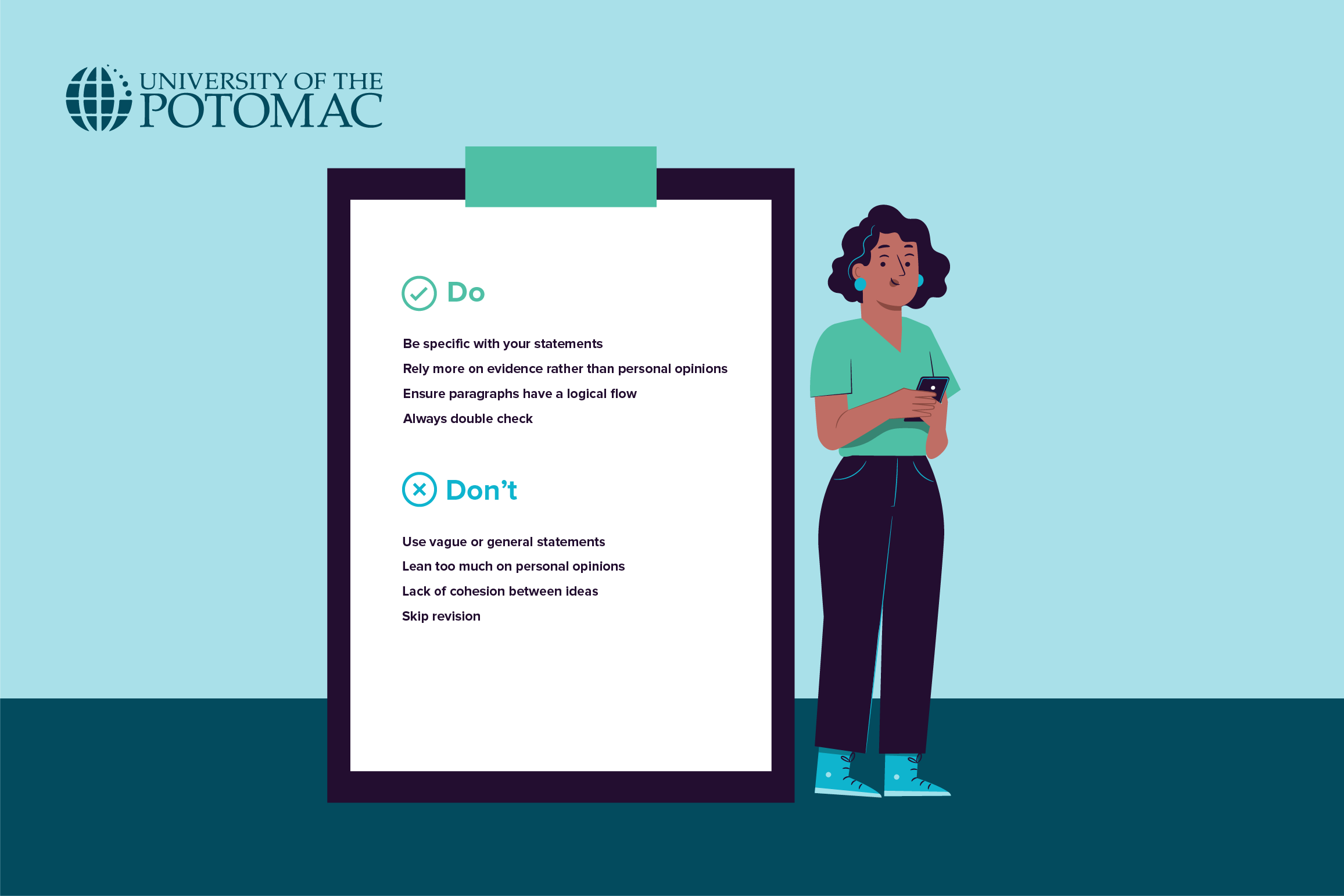Key Takeaways
- When writing an argumentative essay, choose a focused, debatable topic that matters to your audience.
- Build your argument with credible research and a clear structure.
- Write with formal, logical, and objective language—and always revise before submitting.
Picture a courtroom. One side makes a claim, the other challenges it, and the strongest argument wins. That’s the heart of an argumentative essay. It’s not about ranting or rambling; it’s about taking a position in a debate and backing it up with reason.
This guide breaks down the writing process into practical, manageable steps. You’ll see how to shape your ideas, find the right evidence, and respond to opposing views with confidence.
Steps to Writing an Argumentative Essay

Writing an argumentative essay can feel overwhelming at first. But once you understand the structure and approach it step by step, the process becomes much smoother and far less intimidating.
Choose a debatable topic
The heart of an argumentative essay lies in the topic. A good one doesn’t have a single obvious answer; it rather invites disagreement. Because if everyone instantly agrees with your position, it’s not really up for debate.
A debatable topic presents at least two sides, each with valid arguments. Think of issues like school uniforms, animal testing, or the influence of social media. People have strong opinions, and they often clash.
That said, not every idea makes for a solid essay. Topics that are too broad, like “technology,” are difficult to manage. You’ll find yourself trying to say too much with too little space. On the other hand, topics that are too niche might not interest most readers or offer enough research material.
Aim for relevance. Pick something your audience cares about—something timely, relatable, or thought-provoking. The more engaged you are with the topic, the easier it will be to argue your case convincingly.
Research and gather evidence
Once you have your topic, it’s time to dig in. Research is where your argument gets its muscle. Start with credible sources like academic journals, expert-written books, and respected news outlets. Avoid random blogs or biased websites. You want facts that can stand up to scrutiny.
But don’t just look for information that supports your opinion. Strong argumentative essays also recognize opposing viewpoints. Understanding what the “other side” says helps you build better counterarguments. It shows that you’ve done your homework and aren’t just making a one-sided claim.
As you read, take notes. Write down key statistics, powerful quotes, and summaries of major points. Keep track of where you found each detail, as it’ll save time later when you cite your sources. Consider using digital folders or note cards to organize the evidence into categories. When it’s time to write, having everything sorted makes your job a lot easier.
Create an outline
Before you start writing, sketch out a plan. An outline keeps your ideas in order and your argument on track. It’s easy to get lost in your thoughts when you dive straight into the essay, but an outline brings structure to your thinking.
Begin by laying out your main argument. What’s your position? What’s the core message you want the reader to walk away with? Then, map out your main points that will support this stance. Under each point, jot down the evidence you found during your research.
Outlining isn’t about writing full sentences. It’s more like making a blueprint. Think of it as the skeleton that holds your essay together. With a clear outline, you’ll know where each part of your argument fits, and the writing itself becomes much less stressful.
Write the introduction
Your introduction sets the tone. It’s your first chance to pull the reader in and make them care about your argument. So, start with something that grabs attention. That could be a question, a bold statement, or a surprising fact related to your topic. This is your hook.
Next, give some background. If your reader needs context to understand the issue, now’s the time to provide it. What you need is just enough to frame the debate, not so much that it becomes a history lesson.
Then comes the most important part: the thesis statement. A good thesis is specific, clear, and argumentative. It doesn’t just say what your essay is about, but it tells us where you stand.
“School uniforms are unnecessary in public schools” is much stronger than “This essay is about school uniforms.” The thesis is your compass. Every paragraph that follows should connect back to this central point, so make it sharp and focused.
Develop body paragraphs
The body of your essay is where your argument unfolds, one step at a time. Each paragraph should focus on a single key point that supports your thesis. Start with a topic sentence that clearly states the idea. Follow that with evidence—this could be a quote, statistic, or real-world example. Then, explain how that evidence supports your point. Avoid dumping information without tying it back to your main argument.
As you move from one paragraph to the next, keep your writing connected. Use transition words or short linking phrases to guide the reader. This helps your essay flow smoothly instead of feeling like a collection of unrelated thoughts.
Three to four solid body paragraphs are usually enough, depending on your essay length and the complexity of your argument. Make sure each one adds something new. So, if you find yourself repeating ideas, take a step back and refocus your outline.
Address counterarguments
Bringing up opposing views might feel like you’re weakening your stance, but it actually does the opposite. When you take the time to address counterarguments, you show that you’ve considered different perspectives. It adds credibility and makes your argument harder to dismiss.
Choose one or two common objections to your position. Present them fairly and avoid using sarcasm or loaded language. This isn’t the part to mock the other side; it’s your chance to engage with it respectfully and show why your argument still stands strong.
Once you present the counterpoint, follow it up with a well-reasoned rebuttal. Use logic, evidence, or a shift in perspective to explain why your position holds more weight. You can place this section after your main body paragraphs or weave it into the flow if it fits naturally. Either way, it helps build a well-rounded and persuasive essay.
Write the conclusion
A strong conclusion doesn’t just restate what you’ve already said. It gives the reader a sense of closure while reinforcing your main argument. Begin by briefly summarizing your key points and avoid copying your topic sentences or repeating the thesis word for word. Instead, show how everything you’ve discussed connects back to your overall message.
This is also your moment to restate the thesis in a more reflective or confident tone. After walking the reader through your argument, you’ve earned the right to say, “Here’s why this matters.” Make that message clear.
Finally, leave the reader with something to think about. You don’t need to tell them what to do, but you can encourage reflection. Maybe it’s a question, a thought about future implications, or a reminder of the issue’s relevance. A well-written conclusion sticks with the reader long after they’ve finished reading. That’s what gives your essay a lasting impact.
Interested in pursuing a degree?
Fill out the form and get all admission information you need regarding your chosen program.
This will only take a moment.
Message Received!
Thank you for reaching out to us. We will review your message and get right back to you within 24 hours.
If there is an urgent matter and you need to speak to someone immediately you can call at the following phone number:
- We value your privacy.
Tips for Writing a Strong Argumentative Essay

Strong writing doesn’t just come from making points; it also comes from how those points are presented. A thoughtful tone, a clear voice, and smart choices in wording can elevate even a simple argument. Here are some tips that help bring everything together:
- Stick to formal and objective language: Avoid using “I think,” slang, or emotionally charged phrases. Instead, write as if you’re presenting your case to someone who expects professionalism.
- Watch out for logical fallacies: Even a well-researched essay can fall apart if the logic isn’t sound. Avoid weak spots like circular reasoning, false dilemmas, or personal attacks. Stay focused on facts and ideas, not emotions or assumptions.
- Back up each claim with specific evidence: Don’t leave your reader wondering where your information came from. Use sources that are trustworthy and current—academic journals, books, and respected websites—and explain why they matter to your point. Look for websites ending in .edu, .gov, .org, etc.
- Avoid overwhelming your reader: More points don’t mean more power. Choose two to four solid arguments and give them space to breathe. Let the depth of your reasoning do the convincing, not the quantity of ideas.
Common Mistakes to Avoid

When writing an argumentative essay, certain pitfalls can quietly weaken your work if you’re not careful.
One frequent mistake is using vague or general statements. Saying “many people agree” or “this is important” doesn’t tell the reader much. Instead, be specific when mentioning who agrees or why it matters. This gives your argument more weight.
Another trap is leaning too much on personal opinions. While your viewpoint drives the essay, it shouldn’t replace evidence. Imagine saying, “I just feel this is unfair,” without backing it up. To avoid this, always pair opinions with facts or expert support.
Logical flow between paragraphs is crucial but often overlooked. Jumping from one idea to another without clear connections can confuse readers. Use transition phrases like “Furthermore,” or “In contrast,” to guide them through your points.
Finally, don’t skip revision. Many students rush to submit without thoroughly editing. Mistakes in grammar, unclear sentences, or missing citations can undermine credibility. Give yourself time to review your work, read it aloud, or ask someone else to give feedback. Small fixes here make a big difference in how your essay comes across.
Conclusion
Writing an argumentative essay doesn’t have to be overwhelming. With the right topic, solid research, a clear outline, and a confident tone, you’re already halfway there. From crafting strong body paragraphs to handling counterarguments with grace, each step builds on the last.
Keep your language formal, avoid common traps, and always make time to revise. The goal is to make a clear, thoughtful case that others can follow. So next time you sit down to write, use these tips as your guide. With practice, writing an argumentative essay can actually be kind of fun—yes, really.
Frequently Asked Questions
What is the difference between an argumentative essay and a persuasive essay?
An argumentative essay focuses on logic and evidence, while a persuasive essay leans more on emotional appeal and convincing the reader to agree.
How long should an argumentative essay be?
It typically ranges from 1,000 to 2,000 words, depending on your assignment or academic level.
Can I use first-person statements in an argumentative essay?
It’s best to avoid first-person unless your instructor allows it. Formal tone and objectivity are usually preferred.








